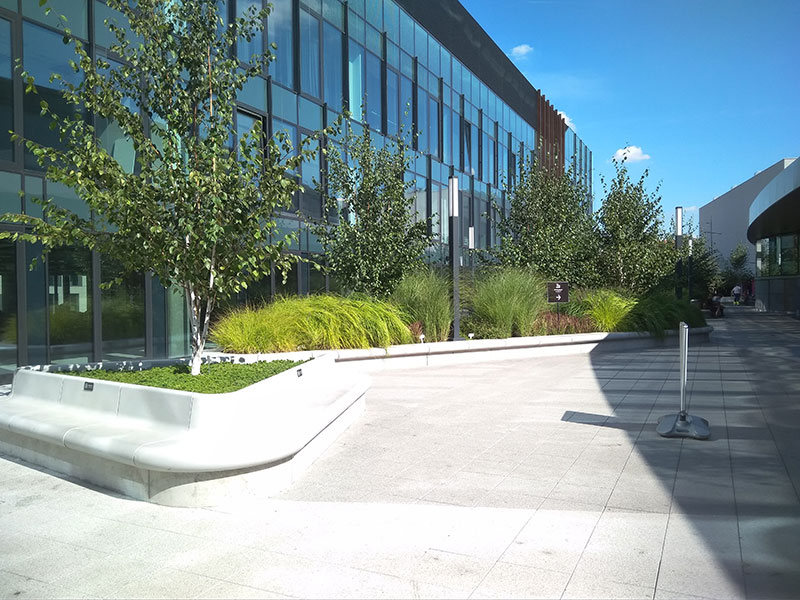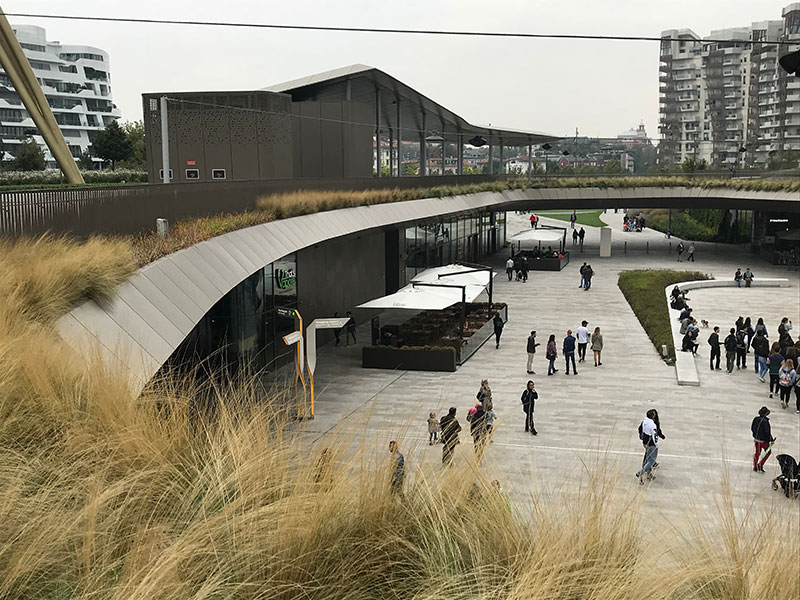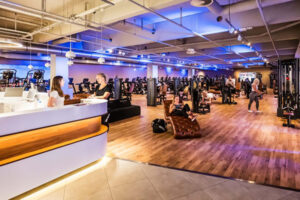By Balbina Gryczyńska
At the turn of the 20th and early 21st centuries, shopping malls were designed in ways that allowed for the inclusion of green projects. Wide corridors and high, glass-paneled ceilings provided favorable conditions for the installation of greenery arrangements.
The green factor might have been one thing (among others) that attracted people to shopping centers at that time. Malls became very popular and due to the fact that they were, by definition, commercially oriented, it was obvious that any space that could be used to sell goods was valuable. Economic rationalism resulted in the critical review of the role of interior landscapes in commercial spaces. The perception of landscape as merely decorative led to greenery being blacklisted.
Fortunately for mankind, the development of e-commerce and mobile technology has forced decision makers to rethink the functions of modern malls. It has become quite evident that if we want to maintain footfall, we need to create micro environments similar to the ones in which people grew up. Old shopping centers were in need of revitalization, and new ones needed to be designed using a completely new concept.
Next Generation Malls and Biophilia
In order to attract people, shopping centers have been transformed into self-sufficient small cities that offer different kinds of activities and entertainment, such as fitness clubs, sports halls, cinemas, theaters, etc. Architects have done their best to provide commercial projects with interiors in which people can feel “at home”. However, one important factor was still greatly lacking – nature.
That fact was discovered by researches from several disciplines, including environmental psychology, sociology, behavioral medicine, and biology. The trend of biophilic design has begun to play a key role: It is a “concept used within the building industry to increase occupant connectivity to the natural environment through the use of direct nature, indirect nature, and space and place conditions. Used at both the building and city-scale, it is argued that this idea has health, environmental, and economic benefits for building occupants and urban environments, with few drawbacks.” (Wikipedia)
As a result of this research, the design of ecological spaces and environments has become a field of interest for the commercial management of shopping malls, given its potential effect on visiting and shopping intentions. The notion that plants, in particular, can play an essential role in the context of architecture has become clear. They can complement and reinforce the existing interior architectural features of buildings or structures, and they can also contribute to the creation of outdoor spaces, simultaneously connecting people to nature.
Advantages of Greenery
There are many benefits of having greenery designed and installed inside shopping centers. Aesthetic values are definitely increased, and environmental and cultural factors are combined. Managers can also appreciate the marketing and publicity functions. Nowadays, “green places” often attract potential visitors, which, consequently, can lead to an increase in property value.
There is no denying that large amounts of greenery installation improve visual values and create different perceptions of public spaces. Rooms with plants are also perceived as more cheerful, pleasant, and inviting. Greenery complements and strengthens architectural design and reduces one’s feeling of being overwhelmed by concrete.
However, the most important benefits are probably those that directly affect humans. People obviously react to indoor environments in markedly different ways, but it has recently become more and more clear to researchers that they derive benefits from plants in a wide range of situations, either through active involvement, like planting or gardening, or passive involvement, such as looking at plants or spending time surrounded by them. Plants and natural settings with vegetation can also help reduce the long-term effects of stress. Plants have a proven power to purify the air by absorbing chemicals from the environment and biodegrading them, as has been shown by many studies, the most famous of which being the list of “NASA plants”. Proximity to plants can generate positive sensations and emotional reactions, such as feeling satisfied and relaxed. That proximity makes people comfortable in public places and promotes the strengthening of interpersonal relationships.
Forms of Greenery Installations
The most common forms of indoor greenery arrangements still consist of potted plants and trees, but since the proximity to nature has begun to play a significant role in public spaces again, apart from the appropriate selection of plants that are incorporated as design elements, architects, landscape architects, and urban planners now work on architectural designs in which greenery harmonizes with natural microclimate factors to create balanced, sustainable, and more livable environments.
The availability of space is also an important factor in many cases. Greenery is often installed in the form of green walls or green ceilings. However, we have to remember that the idea is to create spaces, or microclimates, that are similar to the ones that the plants chosen for the projects would normally have in their own habitats; therefore, access to light must be provided and indoor plants must be protected from sudden temperature changes. Simply put, conditions in which plants can grow must be provided. This, undoubtedly, presents challenges, e.g., the installation of greenery in a “kitchen-like” food court zone, but it is worth the effort.
Investors are more and more willing to provide outdoor spaces, creating parks and green chill-out spaces in front or on the rooftops of shopping malls. This kind of approach helps integrate shopping and commercial architecture with urban structure and public city places, creating a kind of natural path that links the outdoor to the indoor.
Credit: Calla
Summary
Not only are shopping centers places to shop, but they are also places for entertainment, meetings, and relaxation. In addition to stores, cafes, restaurants, beauty parlors, sport halls, and theaters can be found in them. Most people treat shopping at malls as a leisure time activity. Such behavior limits our contact with nature, which makes the transporting of nature inside necessary in order to fulfill a fundamental human need: According to research, even if people are not sensitive to greenery, greenery subconsciously affects their perception and behavior.
One important thing needs to be kept in mind, however: Greenery requires maintenance. Whether a skilled worker with a passion for plants or a professional greenery company is engaged, mall managers need to consider this fact and make provisions for it in their budgets. Greenery that is designed and installed by us has to be taken care of and provided with proper living conditions.
Since modern shopping centers are designed as cities within cities, relaxation and rest zones are also parts of each city, as are properly designated green zones. Therefore, even if some of us are not convinced by this approach yet, we should be open to such a solution in a time in which being ecological and in touch with nature is the trend. Creating spaces that are primarily friendly to mankind, taking care of our physical and mental well-being instead of being completely surrounded by concrete: We should definitely continue to follow the green path.











